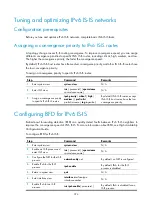
372
Configuring IPv6 IS-IS
IPv6 IS-IS supports all IPv4 IS-IS features except that it advertises IPv6 routing information. This chapter
describes only IPv6 IS-IS specific configuration tasks. For information about IS-IS, see "Configuring IS-IS."
Overview
Intermediate System-to-Intermediate System (IS-IS) supports multiple network protocols, including IPv6. To
support IPv6, the IETF added two type-length-values (TLVs) and a new network layer protocol identifier
(NLPID).
The TLVs are as follows:
•
IPv6 Reachability
—Contains routing prefix and metric information to describe network reachability
and has a type value of 236 (0xEC).
•
IPv6 Interface Address
—Same as the "IP Interface Address" TLV in IPv4 ISIS, except that the 32-bit
IPv4 address is translated to the 128-bit IPv6 address.
The new NLPID is an 8-bit field that identifies which network layer protocol is supported. For IPv6, the
NLPID is 142 (0x8E), which must be carried in hello packets sent by IPv6 IS-IS.
Configuring basic IPv6 IS-IS
Before you configure basic IPv6 IS-IS, complete the following tasks:
•
Configure IPv6 addresses for interfaces to ensure IPv6 connectivity between neighboring nodes.
•
Enable IS-IS.
Basic IPv6 IS-IS configuration can implement the interconnection of IPv6 networks.
To configure basic IPv6 IS-IS:
Step Command
Remarks
1.
Enter system view.
system-view
N/A
2.
Enable an IS-IS process and
enter IS-IS view.
isis
[
process-id
] [
vpn-instance
vpn-instance-name
]
By default, no IS-IS process is
enabled.
3.
Configure the network entity
title (NET) for the IS-IS
process.
network-entity
net
By default, no NET is configured.
4.
Enable IPv6 for the IS-IS
process.
ipv6 enable
The default setting is disabled.
5.
Return to system view.
quit
N/A
6.
Enter interface view.
interface
interface-type
interface-number
N/A
7.
Enable IPv6 for an IS-IS
process on the interface.
isis ipv6 enable
[
process-id
]
The default setting is disabled.
















































